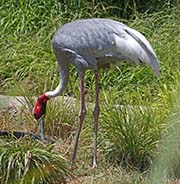Sarus Crane - Grus antigone
| Length | |
| Wingspan | |
| Weight | |
| Clutch Size | |
| Chicks at birth | |
| IUCN Conservation Status | |
Continents: |
The Sarus Crane is found in south-east Asia and Australia and is the tallest of the crane species. They have light grey wings and bodies. The head and the upper neck is red bare skin and the crown is greenish skin. Their pointed bill is long and greenish-grey. The legs and feet are pink and their iris is orange-red. Both sexes are plumage is similar but the male are larger.
The IUCN lists this bird as 'Vulnerable' due to destruction of it environment, pesticides, and the hunting, and the collection of eggs and chicks for trade, food, and medicinal purposes.
Diet: Sarus Cranes feed in shallow water or in fields using their long bills to probe the mud looking for food. They are omnivores and eat insects, aquatic plants, fish, frogs, crustaceans and seeds.
Courtship: Sarus Cranes have an elaborate courtship dance in which they will leap around, do head-bob to each other, and bow with spread wings. Besides being part of the courtship ritual they are done throughout the year which probably strengthens the pair bond. The red skin on the head and neck are a brighter red during the breeding season. Sarus Cranes are monogamous and mate for life.
Nesting: Sarus Cranes build large platform nests made out of reeds and vegetation in shallow waters that are found in marshes or fields. The nest is built up until the platform is above the water (like an island) and can be seen from a distance. The cranes will reuse the nest many times.
The female usually lays 1-2 chalky white eggs which are incubated by both sexes. The chicks are precocial and are born with down and their eyes open. Both parents will feed the chicks when they are first hatched for a few days, but then the chicks will follow their parents and feed independently after that.
Habitat and Range: Sarus Cranes are found in northern India, Nepal, Pakistan, Cambodia, Laos, Vietnam and Australia. They can be found in wetland habitats. They will inhabit cultivated flooded fields.
Vocalization: When alarmed, the parent cranes use a low korr-rr call that signals chicks to freeze and lie still. Also, mated pair of cranes will engage in what is called 'unison calling'. Each sex has a specific posture and will engage in a series of complex and extended calls with each other.
Plumage/Molt Like most cranes, molts annually during the post-breeding season. The main flight feathers are lost at the same time leaving the crane flightless
Migration: Sarus Cranes do not migrate but will make short seasonal movements between wet and dry habitats in Asia and Australia.
Tongue/feet: Like most of the cranes, the hind toe or halux in smaller than the other toes.
Bibliography:
- Archibal, George W. and Meine, Curt, The Cranes: Status Survey and Conservation Action Plan,OICM. G;amd. Switzerland, 1996
- http://en.wikipedia.org The Free Encyclopedia, Accessed July, 2012
- www.savingcranes.org International Crane Foundation, Accessed July, 2012



